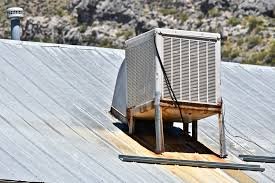Evaporative coolers, often called swamp coolers, are an energy-efficient and eco-friendly way to keep your home cool during hot months. Unlike traditional air conditioning systems, they use water evaporation to cool air, making them particularly effective in dry climates. However, regular maintenance is crucial to ensure they function optimally. Neglecting maintenance can lead to inefficiencies, unpleasant odors, and even mechanical failures.
In this guide, we’ll discuss essential maintenance tips for keeping your residential evaporative cooler running smoothly, ensuring you stay comfortable while maximizing efficiency. We will also address the common question: Does evaporative cooling work effectively?
Understanding How Evaporative Coolers Work
Before diving into maintenance, it’s helpful to understand the basics of how an evaporative cooler functions. These systems draw warm air through water-saturated cooling pads, which absorb heat and cool the air through evaporation. The cooled air is then circulated throughout your home, providing relief from high temperatures.
Evaporative coolers are best suited for dry climates because they add moisture to the air. If you live in a humid area, their cooling efficiency can decrease significantly. So, does evaporative cooling work? The answer depends on your location and how well you maintain the unit.
Regular Maintenance Checklist
Proper maintenance of your evaporative cooler not only improves performance but also extends its lifespan. Follow these essential maintenance tips to keep your system running efficiently:
1. Clean and Replace Cooling Pads Regularly
Cooling pads are the heart of your evaporative cooler. Over time, they can accumulate mineral deposits, dirt, and mold, reducing cooling efficiency. To keep your system in top shape:
- Check the pads monthly during peak usage months.
- Clean or replace them at least once per season, or more frequently if you notice blockages or deterioration.
- Use high-quality pads that are compatible with your cooler model.
2. Inspect and Clean the Water Reservoir
The water reservoir is where the cooling process begins, so it’s essential to keep it clean and free from debris. A dirty reservoir can lead to bacterial growth, which can cause foul odors and poor air quality.
- Drain and clean the reservoir at least once a month.
- Scrub the interior with a mild vinegar solution to remove mineral buildup.
- Refill it with fresh water regularly to prevent stagnation.
3. Maintain the Water Pump and Distribution System
The water pump ensures a steady flow of water to the cooling pads. If it becomes clogged or stops working, your cooler will not function properly.
- Check the pump for debris and clean it as needed.
- Inspect water distribution tubes and unclog any blockages.
- Test the pump at the start of each cooling season to ensure it’s working correctly.
4. Keep the Fan and Motor in Good Condition
The fan and motor push cool air into your home. Regular maintenance can prevent overheating and mechanical failures.
- Lubricate the motor bearings if your unit requires it.
- Inspect the fan belt for wear and tear and replace it if necessary.
- Tighten any loose connections to prevent vibrations or unusual noises.
5. Check for Proper Airflow
Good airflow is key to making sure your evaporative cooler works efficiently. If airflow is obstructed, cooling performance will suffer.
- Ensure that doors and windows are slightly open to allow fresh air circulation.
- Clean air vents and ducts to remove dust and debris.
- Avoid placing objects near the cooler that could block airflow.
6. Prevent Mineral and Scale Buildup
Hard water can cause mineral deposits to form in your evaporative cooler, reducing efficiency and potentially damaging components.
- Use a water treatment solution to minimize mineral buildup.
- Install a water softener if you live in an area with hard water.
- Regularly descale the unit using a vinegar or commercial descaling solution.
7. Store Your Cooler Properly in the Off-Season
When cooler months arrive and your evaporative cooler is no longer needed, proper storage can prevent damage and prolong its lifespan.
- Drain all water from the unit to prevent freezing and mold growth.
- Cover the cooler with a protective cover to keep dust and debris out.
- Store it in a dry area if it is a portable model.
Troubleshooting Common Evaporative Cooler Issues
Even with proper maintenance, issues can arise. Here are some common problems and how to fix them:
Issue: Weak or Insufficient Cooling
- Check the cooling pads – they may be dry or clogged.
- Ensure proper airflow – make sure doors and windows are open.
- Inspect the water pump – it may not be distributing water evenly.
Issue: Strange Odors
- Clean the water reservoir – stagnant water can cause odors.
- Replace old cooling pads – moldy or dirty pads can create unpleasant smells.
- Use an antimicrobial treatment – this helps prevent bacterial growth.
Issue: Loud Noises
- Tighten loose parts – check for vibrations or loose screws.
- Inspect the fan belt – a worn-out belt can create noise.
- Lubricate moving parts – some motors require regular lubrication.
Does Evaporative Cooling Work?
Evaporative cooling is a highly effective and energy-efficient solution for cooling homes in dry climates. However, regular maintenance is essential to ensure it works optimally. By following the tips in this guide, you can extend the life of your evaporative cooler, improve its performance, and enjoy fresh, cool air throughout the hot season.
If you’re wondering if evaporative cooling works for your home, consider factors such as your local climate, the size of your living space, and the maintenance you’re willing to perform. With proper care, evaporative coolers provide an excellent alternative to traditional air conditioning, keeping your home comfortable while using less energy.
By staying on top of regular maintenance, you can ensure that your evaporative cooler continues to run smoothly, providing cost-effective cooling for years to come.
